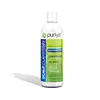What's inside
What's inside
 Key Ingredients
Key Ingredients

 Benefits
Benefits

 Concerns
Concerns

 Ingredients Side-by-side
Ingredients Side-by-side

Water
Skin ConditioningStearalkonium Chloride
PreservativeStearyl Alcohol
EmollientPanthenol
Skin ConditioningAloe Barbadensis Leaf Extract
EmollientMelaleuca Alternifolia Leaf Oil
AntioxidantArnica Montana Flower Extract
MaskingRosmarinus Officinalis Leaf Extract
AntimicrobialUrtica Dioica Leaf Extract
Skin ConditioningSalvia Officinalis Leaf Extract
CleansingHydrolyzed Wheat Protein
Skin ConditioningGlycerin
HumectantPhenoxyethanol
PreservativeHydroxyethylcellulose
Emulsion StabilisingWater, Stearalkonium Chloride, Stearyl Alcohol, Panthenol, Aloe Barbadensis Leaf Extract, Melaleuca Alternifolia Leaf Oil, Arnica Montana Flower Extract, Rosmarinus Officinalis Leaf Extract, Urtica Dioica Leaf Extract, Salvia Officinalis Leaf Extract, Hydrolyzed Wheat Protein, Glycerin, Phenoxyethanol, Hydroxyethylcellulose
Water
Skin ConditioningCetyl Alcohol
EmollientStearyl Alcohol
EmollientGlycerin
HumectantCaprylic/Capric Triglyceride
MaskingPrunus Speciosa Flower Extract
HumectantRosa Centifolia Flower Extract
AstringentZea Mays Silk Extract
Skin ConditioningGuar Hydroxypropyltrimonium Chloride
Skin ConditioningLonicera Japonica Flower Extract
Skin ConditioningPassiflora Edulis Fruit Extract
Skin ConditioningCitric Acid
BufferingPhenoxyethanol
PreservativePlumeria Alba Flower Extract
Skin ConditioningTocopheryl Acetate
AntioxidantParfum
MaskingPanthenol
Skin ConditioningDehydroacetic Acid
PreservativeAloe Barbadensis Leaf Juice
Skin ConditioningBenzyl Alcohol
PerfumingWater, Cetyl Alcohol, Stearyl Alcohol, Glycerin, Caprylic/Capric Triglyceride, Prunus Speciosa Flower Extract, Rosa Centifolia Flower Extract, Zea Mays Silk Extract, Guar Hydroxypropyltrimonium Chloride, Lonicera Japonica Flower Extract, Passiflora Edulis Fruit Extract, Citric Acid, Phenoxyethanol, Plumeria Alba Flower Extract, Tocopheryl Acetate, Parfum, Panthenol, Dehydroacetic Acid, Aloe Barbadensis Leaf Juice, Benzyl Alcohol
 Reviews
Reviews

Ingredients Explained
These ingredients are found in both products.
Ingredients higher up in an ingredient list are typically present in a larger amount.
Glycerin is already naturally found in your skin. It helps moisturize and protect your skin.
A study from 2016 found glycerin to be more effective as a humectant than AHAs and hyaluronic acid.
As a humectant, it helps the skin stay hydrated by pulling moisture to your skin. The low molecular weight of glycerin allows it to pull moisture into the deeper layers of your skin.
Hydrated skin improves your skin barrier; Your skin barrier helps protect against irritants and bacteria.
Glycerin has also been found to have antimicrobial and antiviral properties. Due to these properties, glycerin is often used in wound and burn treatments.
In cosmetics, glycerin is usually derived from plants such as soybean or palm. However, it can also be sourced from animals, such as tallow or animal fat.
This ingredient is organic, colorless, odorless, and non-toxic.
Glycerin is the name for this ingredient in American English. British English uses Glycerol/Glycerine.
Learn more about GlycerinPanthenol is a common ingredient that helps hydrate and soothe the skin. It is found naturally in our skin and hair.
There are two forms of panthenol: D and L.
D-panthenol is also known as dexpanthenol. Most cosmetics use dexpanthenol or a mixture of D and L-panthenol.
Panthenol is famous due to its ability to go deeper into the skin's layers. Using this ingredient has numerous pros (and no cons):
Like hyaluronic acid, panthenol is a humectant. Humectants are able to bind and hold large amounts of water to keep skin hydrated.
This ingredient works well for wound healing. It works by increasing tissue in the wound and helps close open wounds.
Once oxidized, panthenol converts to pantothenic acid. Panthothenic acid is found in all living cells.
This ingredient is also referred to as pro-vitamin B5.
Learn more about PanthenolPhenoxyethanol is a preservative that has germicide, antimicrobial, and aromatic properties. Studies show that phenoxyethanol can prevent microbial growth. By itself, it has a scent that is similar to that of a rose.
It's often used in formulations along with Caprylyl Glycol to preserve the shelf life of products.
Stearyl Alcohol is a type of fatty alcohol from stearic acid. It is a white, waxy compound used to emulsify ingredients.
Fatty Alcohols are most often used as an emollient or to thicken a product. Emollients help soothe and hydrate the skin by trapping moisture.
They are usually derived from natural fats and oils and therefore do not have the same drying or irritating effect as solvent alcohols. FDA allows products labeled "alcohol-free" to have fatty alcohols.
Learn more about Stearyl AlcoholWater. It's the most common cosmetic ingredient of all. You'll usually see it at the top of ingredient lists, meaning that it makes up the largest part of the product.
So why is it so popular? Water most often acts as a solvent - this means that it helps dissolve other ingredients into the formulation.
You'll also recognize water as that liquid we all need to stay alive. If you see this, drink a glass of water. Stay hydrated!
Learn more about Water